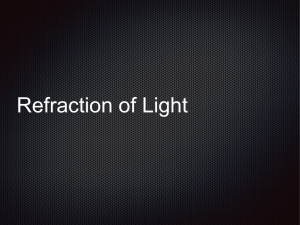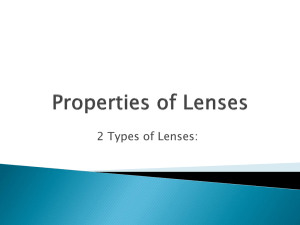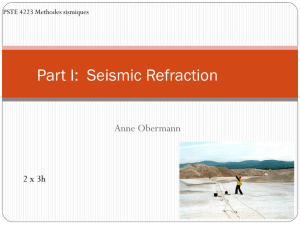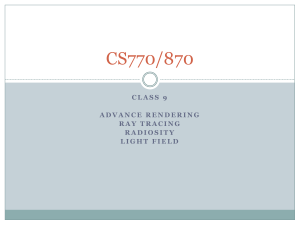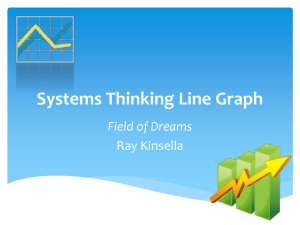Refraction Seismology
advertisement
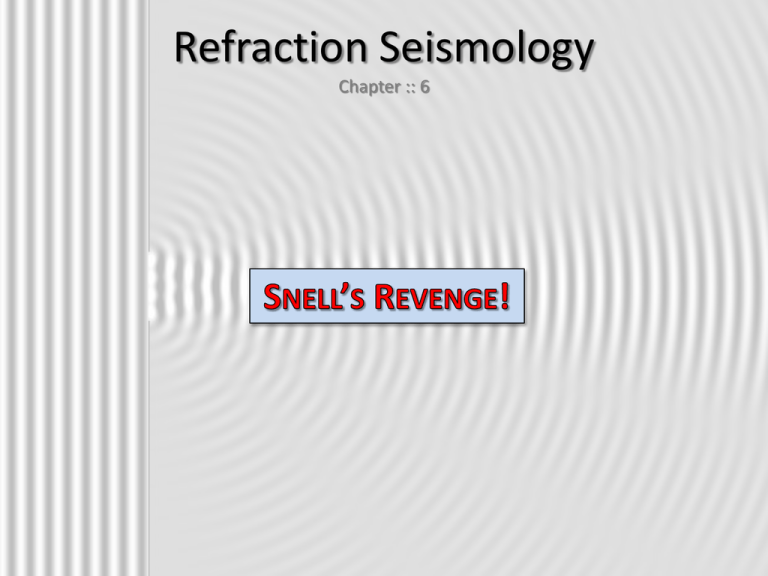
Refraction Seismology Chapter :: 6 Snell’s Law & Critical Refraction • Because seismic sources radiate waves in all directions • Some ray must hit interface at exactly the critical angle, ic • This critically oriented ray will then travel along the interface between the two layers • If more oblique than critical, all wave energy is reflected – The reflected energy is useful too! • E.g. Chapter 7 sin i1 sin i2 v1 v2 sin ic sin 90 v1 v2 sin ic v1 v2 v1 ic arcsin v2 Critical Refraction and Wave Fronts • When a ray meets a new layer at the critical angle… • The ray travels along the interface • What layer is it in? • Rays, aren’t real, so consider the wave fronts… • Wave fronts travel in both layers • Wave front in top continues on the same trajectory • Wave front in Bottom has to be perpendicular to the ray • But the layers have different velocities • This sets up wavelets and head waves… Huygens’s Principle • Recall that rays are not real – They are just an easy way to understand and quantify waves • Wave fronts are what is really happening – But what causes wave fronts? • Huygens’s wavelets explains… – Each point along a material is acts like a point source of waves – Like a pebble dropped into water Huygens’s Wavelets • Huygens (a 17th century Dutch physicist) realized that: – When any particle oscillates it is a tiny source of waves • So, every point on a wave front acts as a small source that generates waves • The waves have circular (spherical) wave fronts and are called wavelets • Wavelets constructively interact (reinforcement) to produce the wave front – Has important implications for diffraction and critical refraction Final Wave Front New Wave Front Wavelets Planar wave front Trough Wavelets and Diffraction • If wavelets didn’t occur, we wouldn’t be able to hear around corners. – Light doesn’t travel around corners very well because of its very high frequency If only there were wavelets… then I could hear you What Up Dr. Kate?? Wavelets and Diffraction • Because of wavelets, a wave front that encounters an obstacle: – Will travel through the open space – The wave front after the barrier diffracts, or bends into an area that is predicted to be a shadow by ray theory. • But what about critical refraction?? (java animation) Final Wave Front Wasuuuup! New Wave Front Wavelets What Up Dr. Kate?? Wavelets and Head Waves • The wave front just above the interface produces a continual stream of critically refracted rays • The wave front just below the interface does the same • These stream of critically refracted rays form wavelets • The wavelets combine to form head waves – The head waves propagate up to the surface and can be recorded. • The recorded rays are called the refracted rays Potential Paths in a Refraction Survey • When doing a seismic refraction survey, a recorded ray can come from three main paths – The direct ray – The reflected ray – The refracted ray • Because these rays travel different distances and at different speeds, they arrive at different times • The direct ray and the refracted ray arrive in different order depending on distance from source and the velocity structure Shot Point (i.e. the Source) ic Layer 1 Layer 2 Receiver Direct Ray ic v1 v2 The Time-Distance (t-x) Diagram Think about: • What would a fast velocity look like on this plot? • Why is direct ray a straight line? • Why must the direct ray plot start at the origin (0,0)? • Why is refracted ray straight line? • Why does refracted ray not start at origin? • Why does reflected ray start at origin? • Why is reflected ray asymptotic with direct ray? The Direct Ray – Simply a linear function of the seismic velocity and the shot point to receiver distance tdirect Shot Point Layer 1 Layer 2 Time (t) • The Direct Ray Arrival Time: x v1 Direct Ray Distance (x) Receiver v1 v2 The Reflected Ray • The Reflected Ray Arrival Time: Time (t) – is never a first arrival – Plots as a curved path on t-x diagram – Asymptotic with direct ray – Y-intercept (time) gives thickness 2h1 v1 • Why do we not use this to estimate layer thickness? Shot Point Distance (x) Receiver Layer 1 v1 Layer 2 v2 The Refracted Ray • The Refracted Ray Arrival Time: – Plots as a linear path on t-x diagram – Only arrives after critical distance – Is first arrival only after cross over distance x 1 1 2h1 2 2 v2 v1 v2 critical distance cross over distance Time (t) • Part travels in upper layer (constant) • Part travels in lower layer (function of x) t 2h1 • Travels long enough in the faster layer 1 1 2 2 v1 v2 Distance (x) ic Layer 1 Layer 2 ic ic ic v1 v2 Making a t-x Diagram Refracted Ray Arrival Time, t t Y-intercept to find thickness, h1 v2 = 1/slope v1 = 1/slope x 1 1 x sin ic 2h1 cosic 2h1 or t 2 2 v2 v1 v2 v1 v1 Refraction…What is it Good For? • Seismic refraction surveys reveal two main pieces of information – Velocity structure • Used to infer rock type – Depth to interface • Lithology change • Water table • Seismic refraction can detect multiple layers • The velocities are easily found from the slopes on the t-x diagram Multiple Layers Multiple Layers • The layer thicknesses are not as easy to find • Recall… x 1 1 t 2h1 2 2 v2 v1 v2 tint1 2h1 1 1 Solve for h … h 1 1 2 2 v1 v2 2 t 1 1 2 2 v1 v2 t v v 2 2 2 21 v1 v2 Now, plug in h1 and solve the remaining layers one at a time… tint 2 2h1 1 1 1 1 2 h 2 2 2 2 2 v1 v2 v2 v3 BEWARE!!! h1, h2, are layer thicknesses, not depth to interfaces. So, depth to bottom of layer 3 /top of layer 4 = h1 + h2 + h3 2 2 Caveats of Refraction • Only works if each successive layer has increasing velocity – Cannot detect a low velocity layer • May not detect thin layers • Requires multiple (survey) lines – Make certain interfaces are horizontal – Determine actual dip direction not just apparent dip Dipping Interfaces • What if the critically refracted interface is not horizontal? • A dipping interface produces a pattern that looks just like a horizontal interface! – Velocities are called “apparent velocities” • What do we do? In this case, velocity of lower layer is underestimated Dipping Interfaces • To determine if interfaces are dipping… • Shoot lines forward and reversed • If dip is small (< 5o) you can take average slope • The intercepts will be different at both ends – Implies different thickness Beware: the calculated thicknesses will be perpendicular to the interface, not vertical Dipping Interfaces • If you shoot down-dip – Slopes on t-x diagram are too steep • Underestimates velocity – May underestimate layer thickness • Converse is true if you shoot up-dip • In both cases the calculated direct ray velocity is the same. • The intercepts tint will also be different at both ends of survey The Hidden Layer • There are two cases where a seismic interface will not be revealed by a refraction survey. – The Hidden Layer (book calls it “Hidden Layer Proper”) – The Low Velocity Layer This one is straightforward, so we will look at it first. The Low Velocity Layer • If a layer has a lower velocity than the one above… – There can be no critical refraction • The refracted rays are bent towards the normal – There will be no refracted segment on the t-x diagram – The t-x diagram to the right will be interpreted as • Two layers • Depth to layer 3 and Thickness of layer1 will be exaggerated The Low Velocity Layer • Causes: – Sand below clay – Sedimentary rock below igneous rock – (sometimes) sandstone below limestone • How Can you Know? – Consult geologic data! • Boreholes / Logs • Geologic sections • Geologic maps The Hidden Layer • Recall that the refracted ray eventually overtakes the direct ray (cross over distance). • The second refracted ray may overtake the direct ray first if: – The second layer is thin – The third layer has a much faster velocity Show Maple Animations Geophone Spacing / Resolution • Often near surface layers have very low velocities – E.g. soil, subsoil, weathered top layers of rock – These layers are likely of little interest – But due to low velocities, time spent in them may be significant • To correctly interpret data these layers must be detected • Decrease geophone spacing near source • This problem is an example of…? Undulating Interfaces • Undulating interfaces produce non-linear t-x diagrams • There are techniques that can deal with this – delay times & plus minus method – We won’t cover these techniques… Detecting Offsets • Offsets are detected as discontinuities in the t-x diagram – Offset because the interface is deeper and D’E’ receives no refracted rays. Fan Shooting • Discontinuous targets can be mapped using radial transects: called “Fan Shooting” – A form of seismic tomography Ray Tracing • All seismic refraction techniques discussed thus far are inverse methods • One can also fit seismic data to forward models using Snell’s law, geometry, and a computer – Initial structure is “guessed” and then the computer uses statistical versions of “guess and check” to fit the data. – Model generates synthetic seismograms, which are compared to the real seismograms Survey Types • The simplest (and cheapest) type of survey is called a hammer seismic survey – – – – A sledgehammer is whacked into a steel plate Impact switch tells time=0 First arrivals are read digitally or inferred from seismogram Because swinging a hammer is free, only one geophone is needed • More can be used, but single geophones must be along a linear transect Survey Types • The maximum workable distance depends on: – The sensitivity of the system – The strength of the sledgehammer whacks – The amount of noise • Wind shakes trees, etc… • Cars, footsteps, HVAC, traffic, etc… • Surveys may be done at night to minimize noise Survey Types • Often the signal to noise ratio is very poor: – Stacking is often used to help delineate first arrivals • General rule of thumb: – Geophone array should be about 10x the depth to interface – 100 meters is the typical upper limit on length of hammer seismic transect • So hammer seismics are best for shallow interfaces (< 10 m) Other Survey Types • Explosion seismics – Offers a much stronger signal • Can detect deeper features • Often involves water explosions (much cheaper) • Geophones / Seismometers are often linked wirelessly (RF / radio waves) • Marine Surveys – Sometimes use explosives, compressed air, high voltage charges, or many other types. – Usually use hydrophones • Respond to pressure changes (p-waves) • Surveying is often done while the ship is moving, so very long transects can be done at a lower cost

